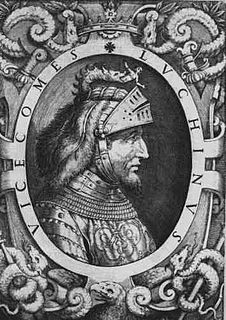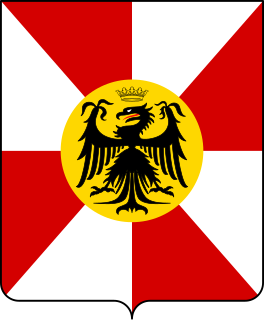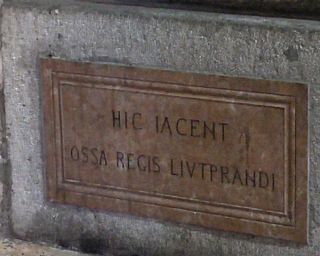Pinalla Aliprandi | |
|---|---|
 Coat of arms of Family Aliprandi | |
| Born | |
| Died | |
| Nationality | Duchy of Milan |
| Occupation | Commander |
| Years active | 1329-1341 |
Pinalla Aliprandi (Monza, end of the 13th century - 1341) was a Milanese commander of the 14th century.
Pinalla Aliprandi | |
|---|---|
 Coat of arms of Family Aliprandi | |
| Born | |
| Died | |
| Nationality | Duchy of Milan |
| Occupation | Commander |
| Years active | 1329-1341 |
Pinalla Aliprandi (Monza, end of the 13th century - 1341) was a Milanese commander of the 14th century.


Born in Monza, son of Rebaldo, brother of Martino and Salvarino, took to entering military career in the army of Azzone Visconti. Belonged to one of the most important families of Monza, but residing in Milan. In April 1333 led to the rescue of six hundred infantry of Ferrara, besieged by the papal legate Bertrando del Poggetto, and on 14 of the month, along with troops from Verona, Gonzaga and Florence, defeated the Papal army. In the same year he was mayor of Bergamo. In 1336, again at the head of an army of Azzone, ravaged the lands around Piacenza and participated in the siege of the city, which capitulated in the hands of the Visconti. In 1339, when Lodrisio Visconti made against Milan, Pinalla, as captain general of the army of Azzone, made against the five hundred horses, but failed to arrest the passage of the Adda, in Parabiago, February 21, the decisive battle took place, ended with the victory of the army of Azzone's fortunes. After the death of Azzone (August 16, 1339), Pinalla was taken aside by Luchino Visconti and in 1341 became part of the conspiracy against him by Pusterla and other noble Milanese. Discovery of the conspiracy, Pinalla, along with his brother Martino, was arrested, tortured and starved to death. [1]

Monza is a city and comune on the River Lambro, a tributary of the Po in the Lombardy region of Italy, about 15 kilometres north-northeast of Milan. It is the capital of the Province of Monza and Brianza. Monza is best known for its Grand Prix motor racing circuit, the Autodromo Nazionale di Monza, which hosts the Formula One Italian Grand Prix with a massive Italian support tifosi for the Ferrari team.

Galeazzo II Visconti was a member of the Visconti dynasty and a ruler of Milan, Italy.

The Visconti of Milan are a noble Italian family. They rose to power in Milan during the Middle Ages where they ruled from 1277 to 1447, initially as lords then as dukes, and several collateral branches still exist. The effective founder of the Visconti lordship of Milan was the archbishop Ottone, who wrested control of the city from the rival Della Torre family in 1277.

Parabiago is a town located in the north-western part of the Metropolitan City of Milan, Lombardy, northern Italy.

The Battle of Parabiago was fought in February 1339 near Parabiago, in Lombardy, northern Italy, between the Milanese army and the St. George's Mercenaries of Lodrisio Visconti. A renowned condottiero, the latter was an exiled member of the Visconti family then in power in Milan with a kind of triumvirate formed by Azzone and his uncles, Luchino and Archbishop Giovanni Visconti. Aiming to return victoriously to his city, he hired some 2,500 knights, mainly from Germany, and 1,000 Swiss infantry which had fought in the unsuccessful war of Mastino II della Scala for the hegemony in northern Italy. These units were led by Werner von Urslingen and Konrad von Landau.
Lodrisio Visconti was an Italian condottiero.

Azzone Visconti was lord of Milan from 1329 until his death. After the death of his uncle, Marco Visconti, he was threatened with excommunication and had to submit to Pope John XXII. Azzone reconstituted his family's land holdings, taking numerous cities. He died in 1339.

Luchino Visconti (also spelled Lucchino, 1287 or 1292 – January 24, 1349) was lord of Milan from 1339 to 1349. He was also a condottiero, and lord of Pavia.

Ottone Visconti was Archbishop of Milan and Lord of Milan, the first of the Visconti line. Under his rule, the commune of Milan became a strong Ghibelline city and one of the Holy Roman Empire's seats in Italy.

Galeazzo I Visconti was lord of Milan from 1322 to 1327. After being chosen Captain of Milan, he defeated two papal armies and was excommunicated by Pope John XXII. Temporarily imprisoned for murder, Galeazzo retired to Pescia and died in August 1328.

Milan, Italy is an ancient city in northern Italy first settled in about 400 BC by Celtic Insubres. The settlement was conquered by the Romans in 222 BC and renamed it Mediolanum. Diocletian divided the Roman Empire, choosing the eastern half for himself, making Milan the seat of the western half of the empire, from which Maximian ruled, in the late 3rd and early 4th century AD. In 313 AD of Milan, which officially ended the persecution of Christians. In 774 AD Milan surrendered to Charlemagne and the Franks.

Louis II, son of Louis I of Vaud of the House of Savoy, was the Baron of Vaud from 1302 until his death. A military man, he fought widely in Italy and, during the first phase of the Hundred Years' War, in France. As a diplomat he visited England and the papal court in Rome and Avignon, and he served as regent of the County of Savoy between 1343 and his death, during which period he was the leader of the House of Savoy.

Martino Aliprandi was an Italian lawyer and mayor of the 14th century.

Salvarino Aliprandi was an Italian Legal Counsel of the 14th century.

The Aliprandi is an Italian family originally from Milan, descending from the Lombards. Wealthy feudal lands in various parts of Lombardy, had supremacy over the city of Monza in municipal period. The House of Aliprandi gave the Catholic Church Blessed Catherine Aliprandi.

Giovanni Aliprandi was an Italian nobleman. He was Count Palatine and captain of the Holy Roman Empire and lived in Milan, in the parish of San Simpliciano.
Estorre Visconti, or Astorre according to other sources, was one of the many illegitimate sons of the famous Bernabò Visconti, Lord of Milan and already deposed by his nephew Gian Galeazzo Visconti in 1385.

Sister Virginia Maria was an Italian nun.

The Visconti Castle of Crenna is a castle of mediaeval origin located in Crenna, frazione of Gallarate, Lombardy, Northern Italy. It is linked to the fame of Lodrisio Visconti, who raised against and then reconciled with the members of the family of his cousin Matteo Visconti, Lord of Milan. In the 14th century, the castle underwent expansion and destruction according to the alternative fortunes of Lodrisio.

Beatrice d’Este was an Italian noblewoman, now primarily known for Dante Alighieri's allusion to her in Purgatorio, the second canticle of the Divine Comedy. Through her first marriage to Nino Visconti, she was judge (giudichessa) of Gallura, and through her second marriage to Galeazzo I Visconti, following Nino’s death, lady of Milan.